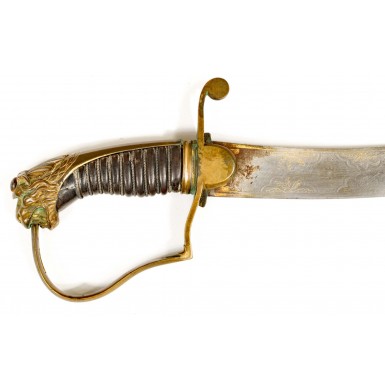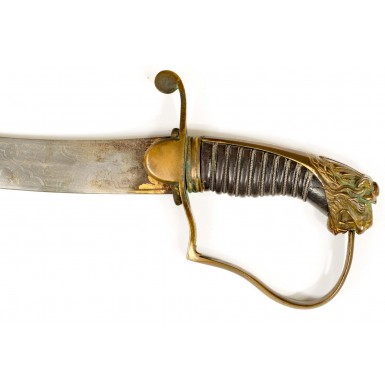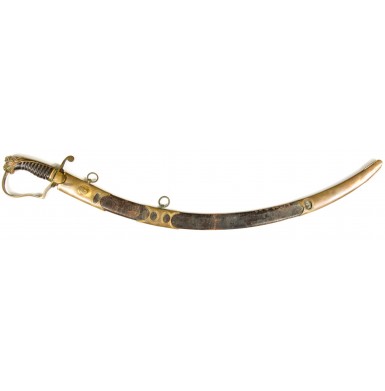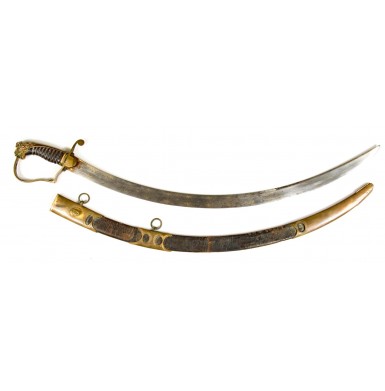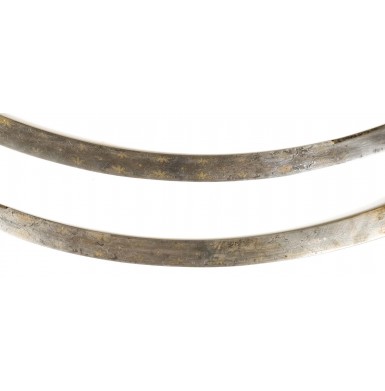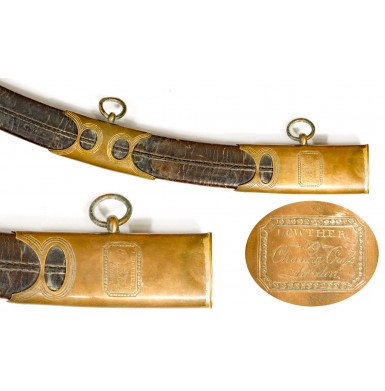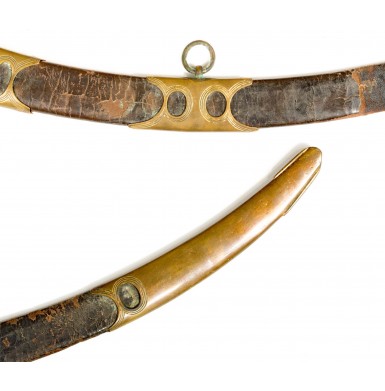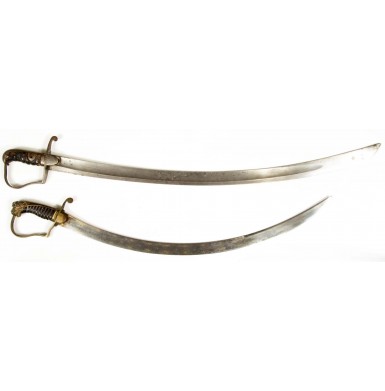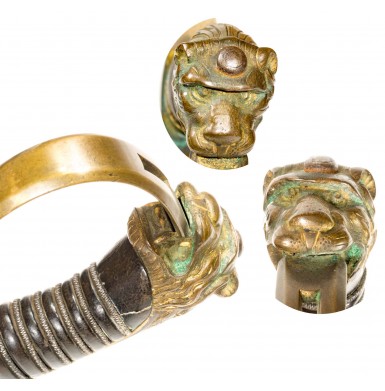British Pattern 1796 Light Cavalry Officer's Saber by Osborn & Gunby
- Product Code: EWSK-1588-SOLD
- Availability: Out Of Stock
-
$1,995.00
In 1796, the British War Department adopted a newly designed saber for use by the Light Cavalry. This included the Hussars, the Light Dragoons and the Horse (Mounted) Artillery. John Gaspard Le Merchant, a British cavalry officer, designed the saber based upon his military experiences in the field. Le Merchant saw the inadequacies in the British Pattern 1788 cavalry saber design, as well as the failure of the accompanying tactics, while he was serving as a brigade major with the British Cavalry in Flanders, during the Low Countries campaign in the early years of the French Revolutionary Wars (1793-1795). Upon returning to England, he enlisted the aid of English cutler and sword maker Henry Osborn (some references spell the name with an “e” at the end, but Osborn blades are not so marked) and between them was born the Pattern 1796 Light Cavalry Saber. The saber had a curved blade with relatively short, slashing tip, referred to by some as a “hatchet” tip. The blade was typically between 32 ½” and 33” long and had a simple stirrup shaped iron guard with a pair of languets on either side of the guard to “trap” an enemy’s blade. The grip had a grooved wood core, which was wrapped with braided cord and then wrapped with leather, without an exterior wrap of wire as was typical of many sabers of the era. A pair of iron “ears” extended down from the backstrap on either side of the grip’s center, and a transverse pin reinforced the grip to backstrap attachment; strengthening it and keeping the grip from wobbling or working itself loose from the hilt. Le Merchant’s design was strictly for hacking and slashing, and not for thrusting, as the Pattern 1796 Heavy Cavalry saber was intended. Le Merchant credited the sword designs of the Hungarians, Turks and Moors for his inspiration to create a heavily curved blade that actually got wider near the tip. As the saber was designed and balanced for hacking and slashing at an enemy, it was the last 10” or so of the blade, nearest the tip that saw the most use in combat, and that usually shows the most use on extant examples. This area was often sharpened to a near razor like edge, and period accounts have been known to compare the effect of the 1796 Light Cavalry saber upon its enemy to meat being assaulted by a giant slicer! Le Merchant not only designed the saber, but also the accompanying tactics, and taught that the saber should be used to strike at the head and arms of enemy cavalrymen, rather than to thrust at them.
British cavalryman George Farmer, who was serving with the 11thRegiment of Light Dragoons during the Peninsular Campaign against Napoleon, recalled one account of the effectiveness of the P1796 in combat. During a skirmish with French cavalry on the Guadiana River, Farmer remembered:
“Just then a French officer stooping over the body of one of his countrymen, who dropped the instant on his horse’s neck, delivered a thrust at poor Harry Wilson’s body; and delivered it effectually. I firmly believe that Wilson died on the instant yet, though he felt the sword in its progress, he, with characteristic self-command, kept his eye on the enemy in his front; and, raising himself in his stirrups, let fall upon the Frenchman’s head such a blow, that brass and skull parted before it, and the man’s head was cloven asunder to the chin. It was the most tremendous blow I ever beheld struck; and both he who gave, and his opponent who received it, dropped dead together. The brass helmet was afterwards examined by order of a French officer, who, as well as myself, was astonished at the exploit; and the cut was found to be as clean as if the sword had gone through a turnip, not so much as a dint being left on either side of it.”
The design was so successful and well received that the Prussian Pattern 1811 Blucher Saber was a nearly direct copy of Le Merchant’s design, and sabers based upon the P1796 would serve German cavalry well into the 20th century, and even during the First World War!
The saber was carried in a heavy iron scabbard that was supported by a pair of mounts with a pair of suspension rings. Often the sabers and scabbards that saw service with the British military were rack numbered, and today mixed numbered scabbards and sabers are quite common, as the swords were more likely to be lost on the field than the accompanying scabbards, and a similarly retrieved battlefield pick up usually replaced the lost sword. The Pattern 1796 Light Cavalry saber remained in use with the British cavalry for only a few years after the battle of Waterloo (June 18, 1815), and was officially replaced with the Pattern 1821 Light Cavalry saber, although the effectiveness and the popularity of the P1796 with the troopers resulted in the saber remaining in service for several decades after its official “replacement”, even seeing service as late as the Crimean War with some units, despite having been superseded by two different patterns (both the Pattern 1821 and Pattern 1853).
Not long after the development and adoption of the Pattern 1796 Light Cavalry Saber, Osborn modified the blade to create an officer’s pattern of the sword. This blade was more traditional at the end with less of a hatchet tip. It was tapered and pointed sufficiently to allow the saber to be used for thrusting as well. As British officers were required to provide their own uniforms and sidearms, an amazing amount of latitude was granted to officer’s sabers. As long as the sword conformed to the basic pattern, embellishments were allowed, with the imagination and the pocket book of the buyers being the only major constraints on the design. After the adoption of the Lion Pommel design for the Pattern 1803 Infantry Officer’s Sword, this motif became a popular one to incorporate into Pattern 1796 Light Cavalry Officer’s Sabers. Lion hilt P1796 sabers were not uncommon during the first quarter of the 19thcentury. The blades often were often of a variety of curvatures and lengths, again often at the whim of the officer himself. While the steel scabbards were appropriate and necessary in the saddle, often leather scabbards were acquired as well as the metal ones for wear when not mounted.
Offered here is a VERY GOOD+, complete and solid example of the British Pattern 1796 Light Cavalry Officer’s Saber, complete with its original leather scabbard. The saber was manufactured by one of its originators, Henry Osborn, and is clearly marked:
Osborn & Gunby’s Warranted
in gold gilt script on the spine. Henry Osborn was a Birmingham based manufacturer who produced a wide variety of military goods. Although best known for his swords, and the Pattern 1796 that he helped design, Osborn(e) was also listed as a Gun maker, silversmith, accouterment maker and hilt maker as well as a sword and dirk cutler. Osborn was born in 1756 and was apparently beginning to serve his apprenticeship to a master sword cutler by 1765, which he appears to have completed around 1784. In 1785, Osborn first appears in the Birmingham directories as a sword cutler, working in Brookhouse Lane, and by 1800 is also operating a manufactory on Bordesley Street, known as the Bordesley Street Mills. In 1802, Osborn opened a retail outlet in London at 82 Pall Mall Street. Around 1806, he partnered with John Gunby and from about 1806-1820 the business operated as Osborn & Gunby. In 1807, the London operation was renamed as well and by 1808 the Pall Mall retail outlet was also listed in the directories as Osborn & Gunby. In 1819, the London retail shop moved to 48 Thames Street, where it would remain until its closure in 1838. The Osborn & Gunby partnership ended between 1820 and 1821 and by 1821 Osborn was again listed as the sole operator of his Birmingham and London establishments. In 1827, Henry Osborn died, and his son Thomas and widow Hannah took over the business, continuing to run it under the Henry Osborn name. In 1838, the London retail location was closed, and the Birmingham location was renamed for Thomas Osborn, under whose guidance it continued until 1849. During his life Henry Osborn was appointed Sword Cutler & Accouterment Maker to His Majesty the King and His Royal Highness the Prince of Wales. He was also a founding member of the Loyal Birmingham Light Horse Volunteers, who served as a yeomanry home guard cavalry regiment during the darkest times of a potential French invasion of England, from 1797-1802. Among the other founders of the unit were several notable Birmingham arms makers of the period, including gunmakers & cutlers Thomas Ketland, JamesWooley & William Sargant.
The reverse of the throat is engraved with the retailer information in four lines:
Lowther
-59-
Charing Cross
London
J.S. Lowther was a London based gun & accoutrement maker and sword cutlerwho worked from 1811-1815. This allows us to date this particular sword to this very tight, four year period at the height of the Napoleonic Wars and the War of 1812.
The blade of the saber measures a very easy to handle 26 ¾”, significantly shorter than the “regulation” 32 ½”-33” length for the trooper’s saber. A photo is included that shows the relative size of this sword versus a standard P1796 trooper's saber. The other saber is shown for comparison only and is not included for sale with the P1796 officer's sword. The overall length of the sword is 32”, including the 5 ¼” reverse-P guard hilt with a Lion’s Head pommel. The blade measures only 1 3/8” wide at the ricasso and rather than the trooper’s saber it tapers towards the tip, rather than widening. The saber has the more pointed, officer’s pattern tip with a 9 ½” false edge. The blade is dramatically curved, much more so than a typical P1796 saber, and is decorated with a 19” deeply etched and gilt panel with geometric, floral and astronomical images that evoke Middle Eastern and Islamic themes. The terminating design further evokes the classical Islamic architectural arches and even suggest the minarets of a mosque. The extreme blade curvature and the decorations certainly suggest the scimitars and mameluke blades of the Arab world and it is likely that these themes were requested by an officer who had served in Egypt during that campaign early in the Napoleonic Wars. The Lion’s Head hilt is of gilt brass with a leather covered grooved wooden grip with nine turns of coiled silvered wire. A 1 ¾” forward swept quillon extends from the top of the guard, terminating in a flat disc finial. The sword is contained in its original gilt brass mounted leather scabbard. The mounts include a throat with both a frog button and a suspension ring, a middle mount with a suspension ring and an elongated drag.
As noted, the saber remains in about VERY GOOD+condition. The blade appears to be full-length with only some minor blunting to the tip noted. The metal has a medium pewter patina, with scattered light surface oxidation and discoloration. There is a haze of light surface rust present on the blade, mostly around the ricasso and the spine near the hilt. This could probably be carefully cleaned if so desired. The blade retains most of the deep etching with some light wear and minor loss and also retains about 30%+ of the original gold gilt decorations. There is some minor edge wear and some small nicks along the edge that can be felt, but that are not readily visible to the eye. The hilt retains about 20%+ of its original gold gilt, with loss and wear, and with most of the gilding remaining in the protected areas and recesses of the lion’s face. The balance of the brass hilt has an uncleaned, bronze patina and has also developed some areas of green verdigris, primarily in the recesses of the lion’s face and at the hilt to grip junction.
The original thick leather throat washer remains in place at the hilt to blade junction. The blade to hilt joint remains tight without any wobble or looseness noted. However, the gilt brass ferrule at the front of the grip, behind the guard, is slightly loose. The peen at the pommel is untouched and unmolested. The grip retains most of the original leather grip covering, with only some light areas of wear, and some very minor loss. The leather shows a couple of small tears at the front and rear but remains essentially intact. The coiled silvered wire wrap remains in place, showing some moderate wear, minor loss and some small areas of minor looseness.
The scabbard remains in about GOOD+ to NEAR VERY GOODcondition. The leather remains mostly solid with a couple of creases and areas of weakness between the middle mount and the drag. The gilt brass mounts retains traces to about 10% of their original gold gilding with the balance showing a dark, uncleaned bronze patina that matches the hilt. All three of the mounts are somewhat loose, with the throat loose enough that it can be removed with some effort. The leather shows moderate crazing and finish loss, as well as wear to the leather because of the movement of the mounts. The seam up the rear of the scabbard remains relatively tight and retains most of the stitching, with some loss between the middle and lower mounts. The original suspension rings are in place on the upper and middle mounts. The middle suspension ring is slightly bent. Some traces of oxidized verdigris is present on both suspension rings and around the ring mounts.
Overall this is a very nice example of a British Pattern 1796 Light Cavalry Officer’s Saber, complete with its correct original scabbard. The saber was made by one of the most desirable British sword cutlers of the Napoleonic Era, Henry Osborn, the very man who helped to design it. Even better, the saber can be reasonably dated to between 1811-1815, as those are the working dates of the retailer on the scabbard’s throat. The saber is well marked, as is the scabbard, and is very attractive. The interesting blade decorations certainly suggest Arabic themes, and if the sword was not produced for a British officer who had ties to the Egyptian campaign, it may have been made as a gift for a Middle Eastern pasha or chieftain. During the Napoleonic Wars, control of the Dardanelles was of great strategic importance, so both the English and the French spent a lot of time, effort and treasure trying to influence the various local rulers whose lands bordered this important waterway. Either way, the saber presents wonderfully, is very attractive and was made by one of the most heralded English blade makers of the time, at the height of two of the greatest conflicts of the period; the Napoleonic Wars and the War of 1812.
SOLD
Tags: British, Pattern, 1796, Light, Cavalry, Officer's, Saber, by, Osborn, &, Gunby


